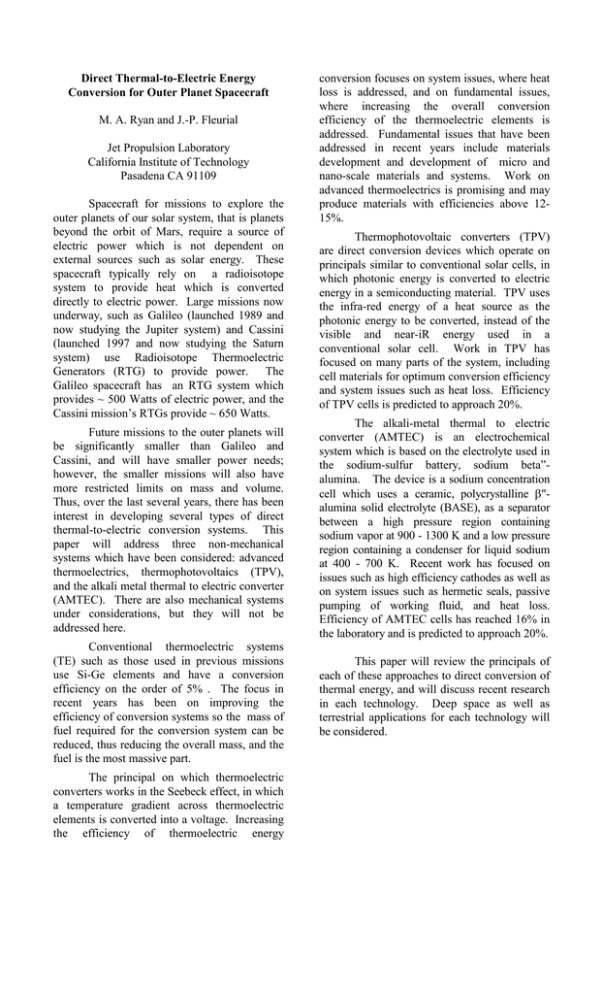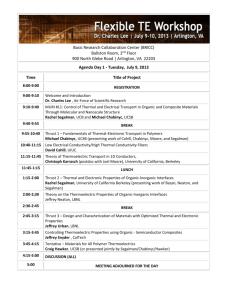Direct Thermal-to-Electric Energy Conversion for Outer Planet
advertisement

Direct Thermal-to-Electric Energy Conversion for Outer Planet Spacecraft M. A. Ryan and J.-P. Fleurial Jet Propulsion Laboratory California Institute of Technology Pasadena CA 91109 Spacecraft for missions to explore the outer planets of our solar system, that is planets beyond the orbit of Mars, require a source of electric power which is not dependent on external sources such as solar energy. These spacecraft typically rely on a radioisotope system to provide heat which is converted directly to electric power. Large missions now underway, such as Galileo (launched 1989 and now studying the Jupiter system) and Cassini (launched 1997 and now studying the Saturn system) use Radioisotope Thermoelectric Generators (RTG) to provide power. The Galileo spacecraft has an RTG system which provides ~ 500 Watts of electric power, and the Cassini mission’s RTGs provide ~ 650 Watts. Future missions to the outer planets will be significantly smaller than Galileo and Cassini, and will have smaller power needs; however, the smaller missions will also have more restricted limits on mass and volume. Thus, over the last several years, there has been interest in developing several types of direct thermal-to-electric conversion systems. This paper will address three non-mechanical systems which have been considered: advanced thermoelectrics, thermophotovoltaics (TPV), and the alkali metal thermal to electric converter (AMTEC). There are also mechanical systems under considerations, but they will not be addressed here. Conventional thermoelectric systems (TE) such as those used in previous missions use Si-Ge elements and have a conversion efficiency on the order of 5% . The focus in recent years has been on improving the efficiency of conversion systems so the mass of fuel required for the conversion system can be reduced, thus reducing the overall mass, and the fuel is the most massive part. The principal on which thermoelectric converters works in the Seebeck effect, in which a temperature gradient across thermoelectric elements is converted into a voltage. Increasing the efficiency of thermoelectric energy conversion focuses on system issues, where heat loss is addressed, and on fundamental issues, where increasing the overall conversion efficiency of the thermoelectric elements is addressed. Fundamental issues that have been addressed in recent years include materials development and development of micro and nano-scale materials and systems. Work on advanced thermoelectrics is promising and may produce materials with efficiencies above 1215%. Thermophotovoltaic converters (TPV) are direct conversion devices which operate on principals similar to conventional solar cells, in which photonic energy is converted to electric energy in a semiconducting material. TPV uses the infra-red energy of a heat source as the photonic energy to be converted, instead of the visible and near-iR energy used in a conventional solar cell. Work in TPV has focused on many parts of the system, including cell materials for optimum conversion efficiency and system issues such as heat loss. Efficiency of TPV cells is predicted to approach 20%. The alkali-metal thermal to electric converter (AMTEC) is an electrochemical system which is based on the electrolyte used in the sodium-sulfur battery, sodium beta”alumina. The device is a sodium concentration cell which uses a ceramic, polycrystalline β"alumina solid electrolyte (BASE), as a separator between a high pressure region containing sodium vapor at 900 - 1300 K and a low pressure region containing a condenser for liquid sodium at 400 - 700 K. Recent work has focused on issues such as high efficiency cathodes as well as on system issues such as hermetic seals, passive pumping of working fluid, and heat loss. Efficiency of AMTEC cells has reached 16% in the laboratory and is predicted to approach 20%. This paper will review the principals of each of these approaches to direct conversion of thermal energy, and will discuss recent research in each technology. Deep space as well as terrestrial applications for each technology will be considered.


